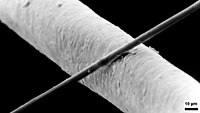
Photo from wikipedia
The determinations of the effects of cyclic loading on the deformation failure characteristics and ultrasonic properties of granite are significant to accurate the evaluations of stability and safety of excavation… Click to show full abstract
The determinations of the effects of cyclic loading on the deformation failure characteristics and ultrasonic properties of granite are significant to accurate the evaluations of stability and safety of excavation damage zones. However, previous experimental studies regarding granite under cyclic loading have not achieved adequate results. This study conducted a series of cyclic tests investigating the mechanical properties and ultrasonic velocities of granite specimens. The results indicated that the stress-strain curves had presented only minimum crack growth phase and no residual strength in the post-peak phase due to the strong brittle properties of the granite. Also, the residual strain of the granite specimens under uniaxial cyclic loading-unloading compression conditions was observed to decrease with the cyclic number as a result of pre-existing crack closure. However, with triaxial cyclic loading, it was found that the residual strain had initially decreased, and then increased after several cycles. It was also was observed that the elastic strain of the granite had displayed increasing trends in both the uniaxial and triaxial cyclic loading-unloading compression experiments. The failure modes in uniaxial cyclic compression tests are known to be complicated, and more failures will be evident with increased damage to the thermoplastic membranes. After confining pressure was applied, the failure mode was determined to mainly be shear fracture and to be less serious than failures observed in the uniaxial cyclic compression tests. The P and S wave velocities showed nonlinear characteristics during the loading processes. The relationship between the dynamic Young’s modulus and the static Young’s modulus could be expressed as a linear function. However, the static Young’s modulus was determined to be larger than the dynamic Young’s modulus. In this present study, both the P and S wave velocities showed that stress related properties first increased and then decreased with the stress.
Journal Title: Bulletin of Engineering Geology and the Environment
Year Published: 2019
Link to full text (if available)
Share on Social Media: Sign Up to like & get
recommendations!